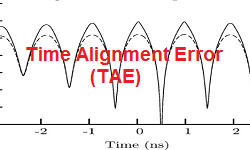5G Transmitted Signal Quality
5G Transmitted signal quality specify how much the transmitted signal deviated from an ideal signal in terms of frequency domain, timer domain or modulation property. The impairments on the transmitted signal are introduced by the transmitter radio parts having nonlinear properties e.g power amplifier.
In the specifications, the signal quality can be assess for a Base Station or Mobile Terminal by measuring following
- Frequency Error (Fe)
- Modulation Quality (EVM)
- Time Alignment Error (TAE)
In this post we will discuss for Time Alignment Error.
Time Alignment Error (TAE)
NR Base station transmits signal from two or more antennas e.g. transmitter diversity and MIMO. For carrier aggregation, the carriers may also be transmitted from different antennas. For mobile device to properly receive and decode the signals from multiple antennas, it is required the signal frames must aligned in time with the defined range.
Frame Timing relation between any two transmitter branches is specified in terms of a maximum time alignment error between transmitter branches. The maximum allowed error depends on the feature or combination of features in the transmitter branches e.g. Transmit Diveristy, MIMO, Carrier Aggression etc. The purpose is to measure this error to find the delay between signal from two transmit Antennas.
Frames of the NR signals present at the BS transmitter antenna connectors or TAB connectors are not perfectly aligned in time. The RF signals present at the BS transmitter antenna connectors or transceiver array boundary may experience certain timing differences in relation to each other.
The TAE is specified for a specific set of signals/transmitter configuration/transmission mode.
- For BS type 1-C, the TAE is defined as the largest timing difference between any two signals belonging to different antenna connectors for a specific set of signals/transmitter configuration/transmission mode.
- For BS type 1-H, the TAE is defined as the largest timing difference between any two signals belonging to TAB
connectors belonging to different transmitter groups at the transceiver array boundary, where transmitter groups are associated with the TAB connectors in the transceiver unit array corresponding to TX diversity, MIMO transmission, carrier aggregation for a specific set of signals/transmitter configuration/transmission mode.
TAE Minimum Requirement for BS type 1-C and 1-H
- MIMO or TX diversity transmissions at each carrier frequency, TAE shall not exceed 65 ns
- In case of intra-band contiguous CA, with or without MIMO or TX diversity, TAE shall not exceed 260ns
- Intra-band non-contiguous CA, with or without MIMO or TX diversity, TAE shall not exceed 3µs.
- Inter-band CA, with or without MIMO or TX diversity, TAE shall not exceed 3µs.
Related Post
- 5G NR Base Station Types
- 5G NR Base Stations Classes
- 5G NR Transmitter Signal Quality Frequency Error
- 5G NR Transmitter Signal Quality Time Alignment Error

